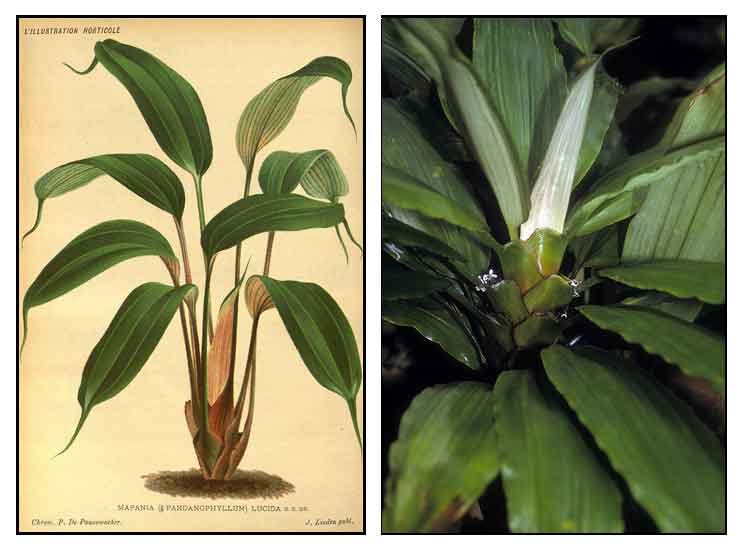
Family • Cyperaceae
Malalubigan
Mapania cuspidata (Miq.) Uittien
| Scientific names | Common names |
| Lepironia cuspidata Miq. | Babakal (Sub.) |
| Lepidstachya praemorsa Zipp. ex Miq. | Maribari (S. L. Bis.) |
| Mapania cuspidata (Miq.). Uittien | Malalubigan (Tag.) |
| Mapania humulis F.-Vill. | |
| Mapania inopinata (Miq.). Uittien | |
| Mapania lucida N.E.Br. | |
| Mapania petiolata C.B.Clarke | |
| Mapania platyphylla Merr. | |
| Mapania stolinifera Uittien | |
| Mapania triquetra Ridl. | |
| Pandanophyllum wendkabduu auct. | |
| Mapania humilis F.-Vill. is a synonym of Mapania cuspidata (Miq.) Uittien The Plant List | |
| Mapania cuspidata (Miq.) Uittien is an accepted name. The Plant List | |
| Lubigan is a common name shared by (1) Acorus calamus, and (2) Mapania humilis, Malalubigan. | |
| Other vernacular names |
| INDONESIAN: Parang hantu, Parang hantu putih, Daung sangkor. |
| MALAYSIA: Siak-siak rimba, sempit (peninsular), penawar fatimah (sarawak), Pandan tikus |
| OTHERS: Pompo onan. |
Distribution Constituents Parts used Uses Studies Availability |
Updated May 2020 / October 2017 / October 2015
![]()
 |
| PHOTOS / ILLUSTRATIONS |
| IMAGE SOURCE: / Mapania cuspidata / Rimba Ilmu Botanic Garden, Kuala Lumpur, Malaysia. Oct. 2002. -- Scott Zona / Creative Commons Attribution / Click on image to go to source page / flickr |
| OTHER IMAGE SOURCE: / Mapania cuspidata (Miq.) Uittien [as Mapania lucida N.E. Br.] / Illustration horticole, vol. 32: t. 557 (1885) / Creative Commons Attribution / /PlantIllustrations |
| Additional
Sources and Suggested Readings (1) Mapania cuspidata / Asia Medicinal Plants (2) Antimicrobial screening of plants used for traditional medicine in the state of Perak, Peninsular Malaysia / C. Wiart, S. Mogana, S. Khalifah, M. Mahan, S. Ismail, M. Buckle, A.K. Narayana, M. Sulaiman / Fitoterapia, 2004; 75: pp 68–73 / https://doi.org/10.1016/j.fitote.2003.07.013 (3) The Use of Medicinal Plant Species by the Temuan Tribe of Ayer Hitam Forest, Selangor, Peninsular Malaysia / FARIDAH HANUM and NURULHUDA HAMZAH / Pertanika J. Trap. Agric. Sci., 1999, 22(2): pp 85-94 (4) Mapania cuspidata / Synonyms / The Plant List (5) Preliminary study of antibacterial properties in Mapania / Nur Syauqina Syasya Binti Mohd Yusoff / Thesis / Plant Resource Science and Technology Department of Plant Science and Environmental Ecology, Faculty of Resource Science and Technology Universiti Malaysia Sarawak (6) Antimicrobial screening of plants used for traditional medicine in the state of Perak, Peninsular Malaysia / C. Wiarta,* et al / Fitoterapia, 2004: 75: pp 68–73 (7) Mapania cuspidata / Plants of the World online / Kew science (8) The ecology use and local knowledge of medicinal plants in Nanga Juoi West Kalimantan Indonesia / Izefri Chaniago / Dissertation, 1996 / University of Montana (9) Medicinal plants used by various ethnic groups in Sarawak / B A Fasihuddin and Laily B Din / Malaysian Journal of Science, 1999; 18: pp 7-11 |
DOI |
• |
| List of Understudied Philippine Medicinal Plants |
 |
• |

 Botany
Botany